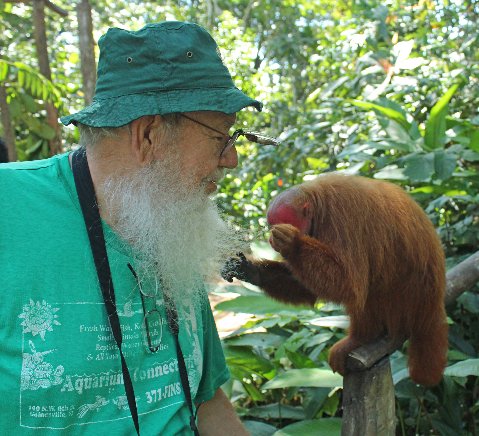The calls of the various anurans were almost deafening as we maneuvered the motor canoe in and out of the beds of floating water lettuce and hyacinths. Pings, squeaks, grunts, groans, beeps, and clicks of various pitches and intensities intermingle and require stopping and listening intently to sort out. Most of the callers were hylids (treefrog family) but occasionally a few leptodactylids (tropical frogs) would also call.

Three of the frog species we were searching for were prominent in this chorus. They were the the 3 taxa of hatchet-faces, treefrogs of the genus
Sphaenorhynchus. Although a rather silly analogy, I have come over the years to think of the 3 as the "3 bears" with Baby Bear being the 1" long
S. carneus, Mama Bear being the slender 1 1/2" long
S. dorisae, and Papa Bear being the robust 1 3/4" long
S. lacteus.
Despite being hylids, these 3 frogs are predominantly aquatic and large numbers of each may be found amidst the islands of aquatic vegetation (especially water lettuce) throughout the year. Besides the size difference, these 3 also differ in call and in appearance. The tiny
S. carneus produces a series of rapidly repeated clicks and has reddish dorsolateral stripes.
S. dorisae has a rounded snout and lacks striping and produces a series of pinging notes. And
S. lacteus has a sharply pointed nose, white canthal (snout) stripes, and its call is a single cluck.
Renewing our acquaintance with these 3 taxa and their fellow songsters is always one of the most enjoyable aspects of our Amazonian tours. And of course there always the chance of seeing a black caiman as well.
This is herping at its neotropical best.
Spotted hatchet-faced treefrog,
Sphaenorhynchus dorisae. "Mama Bear"

Greater hatched-faced treefrog,
Sphaenorhynchus lacteus. "Papa Bear"

 Author, photographer, and columnist Richard Bartlett is one of the most prolific writers on herpetological subjects in the 20th century. With hundreds of books and articles to their credit, Richard and his wife Pat have spent over four decades documenting reptiles both in the field and in captivity. For a list of their current titles, please visit their page in our bookstore. Author, photographer, and columnist Richard Bartlett is one of the most prolific writers on herpetological subjects in the 20th century. With hundreds of books and articles to their credit, Richard and his wife Pat have spent over four decades documenting reptiles both in the field and in captivity. For a list of their current titles, please visit their page in our bookstore. |




To prevent automated Bots from commentspamming, please enter the string you see in the image below in the appropriate input box. Your comment will only be submitted if the strings match. Please ensure that your browser supports and accepts cookies, or your comment cannot be verified correctly.